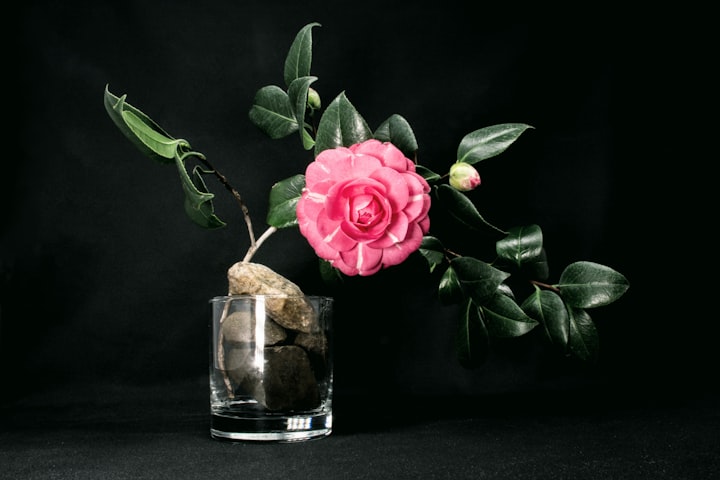The Flower Girl
An Art Lesson from Mother Nature's Canvas

Ikebana. The Japanese always seem to have it all together, don't they? For thousands of years they've been ahead of us, at least when it comes to creating Zen in their lives. Ikebana, is the Japanese art of flower arranging that began developing in the 15th century. While it did take several centuries to become a mainstay in the culture, today, it is seen as a form of therapy, allowing one to change their mood by "influencing the ambiance in their space" through floral design. Basically, it's a simple exercise in appreciation and developing an ability to notice the miraculous beauty and balance of Mother Nature; a quality that always seems to be overlooked by the majority of people racing through life at the texting speed of their thumbs.
While I'm not officially practicing ikebana, I can definitely relate to the Japanese appreciation of flowers and floral arranging. There is so much you can learn from flowers. I say the same thing about my dog, but both are still true. In another life, I would enjoy being a flower, or my dog (she is spoiled rotten). When I think about flowers now, I see the Earth as a canvas, and flowers as Mother Nature handing me some paint. She will surely teach you a lot if you're paying attention.
Believe it or not, many valuable, yet complex elements related to the illusive meaning of life can be found in flowers. Humble gratitude; models of resilience; the value of true love; a sense of balance and direction; even a basic appreciation of each other's uniqueness are all perfectly exemplified. Since my exploration of floral design began, I have made a conscious effort to embrace these life lessons as a continuous means to recharge, and replenish my relationship to the world.
It's no secret that overtly sensitive people are drawn to creative endeavors. We relate them so easily to our emotional world, and live with an ingrained need to pour them out to others in some way. Anything that taps into my sensitivity or creativity inspires me - music, drawing, painting, writing, and yes, even floral study and design - these are the endeavors that bring me the most peace and purpose in my life.
If sensitivity isn't in your wheelhouse, it may seem unbelievable that all the complexities of life could be wrapped up in the simplicity of a flower, a beautiful piece of music or a few lines of poetry, but trust me they are. If you can't see them, might I gently suggest that some reflection is due. After all, these are the things that make life worth all the effort, turmoil and triumph we encounter in it - not a yacht to get to your bigger yacht from your helipad. (I'm looking at you Jeff Bezos.) Allow me to explain.
Models of Resilience/Gratitude
Many flowers need so little from the world to be content. A few hours in the sunlight, a little hydration, maybe a sprinkle of food occasionally, and boom - gorgeous flowers appear. Wildflowers, in particular, are like the nomadic tribes of the flower world. They literally go where the wind takes them, and never really worry too much about anything. They draw me in because of their strength.
They have great resilience in bad times, like a drought, standing tall and strong even in the poorest conditions. They can propagate their species without the help of anyone to maintain them, and will multiply exponentially if you let them. They also give a tremendous amount back to the ecosystem in which they live. Such joie de vivre!

The Value of Love/Beauty
While wildflowers are hearty, some flowers are tender, delicate and carry a mystical beauty. If you've ever seen the variety of orchids in the world, you know what I mean. At the Atlanta Botanical Garden, there is an entire building dedicated to them. They look complex, some almost insect-like, but they are stunningly beautiful. Their patterns, colors and structure are captivating, to say the least.
Unlike wildflowers that just go with the flow, orchids require very specific treatment, temperature and care. They remind you daily of how delicate their life can be, and how important it is to tend to lovely, sensitive things in our world with genuine love.
Always standing just on the precipice of a meltdown at any moment as a self-proclaimed highly sensitive person; I can definitely relate to orchids. I want to be a little less needy, but I just can't seem to figure out how. But provide the right care, and we'll both find ways to thrive.

A Sense of Balance/Direction
Balance and direction are vital in life and flowers. Sunflowers are a great example. With their large seeded center and spritely yellow rays, they form a near perfect circle and say "Hello world!", like the Carol Channing of your garden, but they are also ceaselessly drawn towards the direction of the sun. Turn a sunflower away from the sunlight, and it will shut down. It must find drive, direction and purpose otherwise it grows stagnant and weak.

But balance isn't always related to physical symmetry, as is the case with Birds of Paradise. Their orange spikes imitate wings pointing towards the sky, while a contrasting blue body creates balance through both its complementary color, and the implied weight of its opposing petals.
As it relates to life, Birds of Paradise always remind me that you don't necessarily have to follow a traditional model to succeed. Find a balance and direction that are uniquely your own or embrace the traditional, it doesn't really matter. As long as you are being your genuine self, you'll keep moving forward.

Color/Texture/Structure
What would spark an immediate interest in a flower without its vibrant color, varied texture, or elegant structure? These are the traits that make each flower uniquely the flower they are. They are the elements that add interest, and just as with people, a flower lacking in these traits can leave a dull, lackluster imprint on the world around it.
A human's color and structure are demonstrated through life experiences. Getting outside of your personal norms, finding variety and spicing things up once in a while is important for our ability to thrive and relate to the world, and determine the "color" in our lives.
On the other hand, the texture of a flower relates to human emotion - prickly, smooth, velvety, fuzzy. It's important to be aware of the "textures" you put out in your life, since they can easily impact your relationships with others, and their view of you.
Think of it this way, would you rather hold a cactus or its rose in your bare hands? Listen, we're all a cactus sometimes. The key is to be aware when you're being one, and lessen the negative impact it has on the world around yourself or others.

So there you have it, just a handful of lessons I've learned about life from the joy and peace I've found in flowers and floral design. Perhaps, I'll make it to ikebana eventually. It will probably fall somewhere after mushroom farming, but before glass blowing.
Always remember, flowers are doing their best to demonstrate what's most meaningful in life. Take comfort that Mother Nature knows what matters most. She'll provide a how-to book, if you just take a few minutes to read it every once in a while.
About the Creator
Sydney Chapman
Starting over, yet again.






Comments
There are no comments for this story
Be the first to respond and start the conversation.